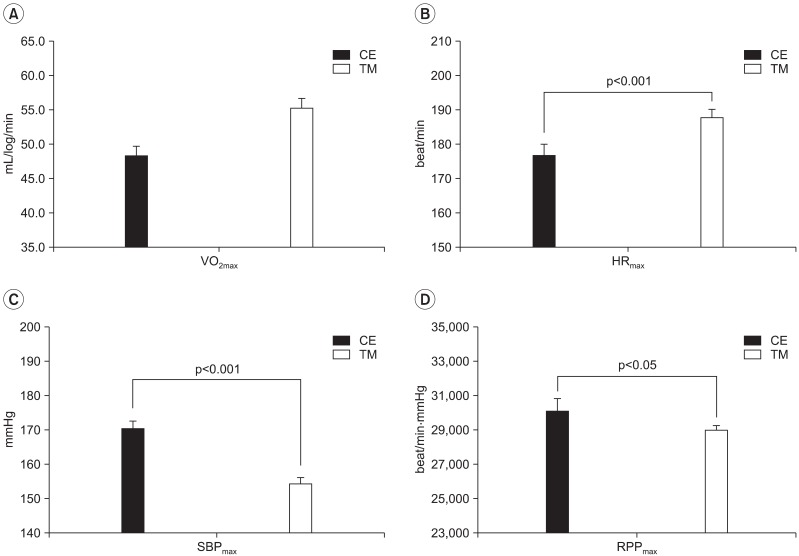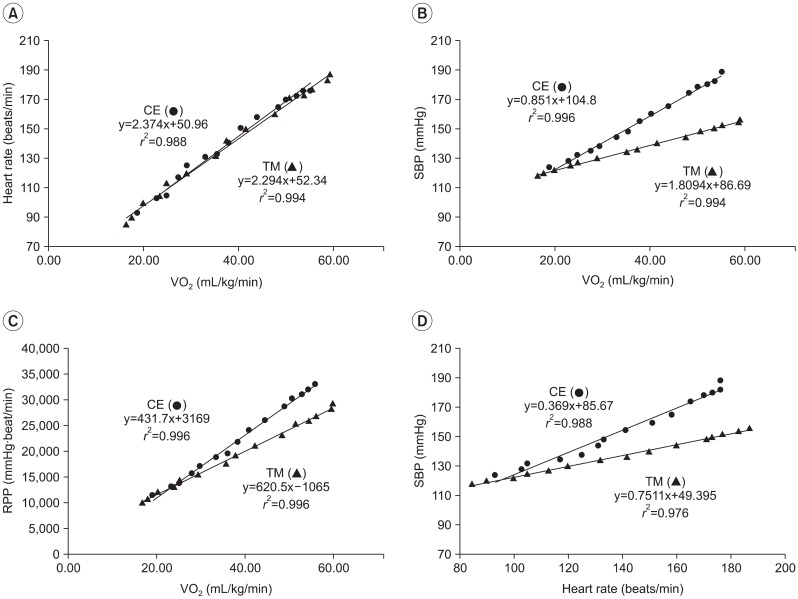Ann Rehabil Med.
2013 Jun;37(3):364-372. 10.5535/arm.2013.37.3.364.
Exaggerated Response of Systolic Blood Pressure to Cycle Ergometer
- Affiliations
-
- 1Department of Rehabilitation Medicine, Inje University Sanggye Paik Hospital, Seoul, Korea.
- 2Division of Physical Education, Soonchunhyang University, Cheonan, Korea.
- 3Sport Science Institute, Korea National Sport University, Seoul, Korea. kimch37@gmail.com
- KMID: 2219533
- DOI: http://doi.org/10.5535/arm.2013.37.3.364
Abstract
OBJECTIVE
The aim of this study is to exam the effects of exercise modes on the systolic blood pressure and rate-pressure product during a gradually increasing exercise load from low to high intensity.
METHODS
Fifteen apparently healthy men aged 19 to 23 performed the graded exercise tests on cycle ergometer (CE) and treadmill (TM). During the low-to-maximal exercises, oxygen uptake (VO2), heart rate (HR), systolic blood pressure (SBP) and rate-pressure product were measured.
RESULTS
CE had a significantly lower maximum VO2 than TM (CE vs. TM: 48.51+/-1.30 vs. 55.4+/-1.19 mL/kg/min; p<0.001). However, CE showed a higher maximum SBP (SBPmax) at the all-out exercise load than TM (CE vs. TM: 170+/-2.4 vs. 154+/-1.7 mmHg; p<0.001). During the low-to-maximal intensity increment, the slope of the HR with VO2 was the same as VO2 increased in times of the graded exercise test of CE and TM (CE vs. TM: 2.542+/-0.100 vs. 2.506+/-0.087; p=0.26). The slope of increase on SBP accompanied by VO2 increase was significantly higher in CE than in TM (CE vs. TM: 1.669+/-0.117 vs. 1.179+/-0.063; p<0.001).
CONCLUSION
The SBP response is stronger in CE than in TM during the graded exercise test. Therefore, there is a possibility that CE could induce a greater burden on workloads to cardiovascular system in humans than TM.
Keyword
MeSH Terms
Figure
Reference
-
1. American College of Sports Medicine. ACSM's guidelines for exercise testing and prescription. 8th ed. Philadelphia: Lippincott Williams & Wilkins;2010.2. Ellestad MH. Stress testing: principles and practice. 5th ed. New York: Oxford University Press;2003.3. Garber CE, Blissmer B, Deschenes MR, Franklin BA, Lamonte MJ, Lee IM, et al. American College of Sports Medicine position stand. Quantity and quality of exercise for developing and maintaining cardiorespiratory, musculoskeletal, and neuromotor fitness in apparently healthy adults: guidance for prescribing exercise. Med Sci Sports Exerc. 2011; 43:1334–1359. PMID: 21694556.4. Fletcher GF, Balady GJ, Amsterdam EA, Chaitman B, Eckel R, Fleg J, et al. Exercise standards for testing and training: a statement for healthcare professionals from the American Heart Association. Circulation. 2001; 104:1694–1740. PMID: 11581152.5. Mezzani A, Agostoni P, Cohen-Solal A, Corra U, Jegier A, Kouidi E, et al. Standards for the use of cardiopulmonary exercise testing for the functional evaluation of cardiac patients: a report from the Exercise Physiology Section of the European Association for Cardiovascular Prevention and Rehabilitation. Eur J Cardiovasc Prev Rehabil. 2009; 16:249–267. PMID: 19440156.
Article6. Myers J, Prakash M, Froelicher V, Do D, Partington S, Atwood JE. Exercise capacity and mortality among men referred for exercise testing. N Engl J Med. 2002; 346:793–801. PMID: 11893790.
Article7. Faulkner JA, Roberts DE, Elk RL, Conway J. Cardiovascular responses to submaximum and maximum effort cycling and running. J Appl Physiol. 1971; 30:457–461. PMID: 5572760.
Article8. Hermansen L, Ekblom B, Saltin B. Cardiac output during submaximal and maximal treadmill and bicycle exercise. J Appl Physiol. 1970; 29:82–86. PMID: 4912876.
Article9. Maeder M, Wolber T, Atefy R, Gadza M, Ammann P, Myers J, et al. Impact of the exercise mode on exercise capacity: bicycle testing revisited. Chest. 2005; 128:2804–2811. PMID: 16236958.10. Pollock ML, Foster C, Schmidt D, Hellman C, Linnerud AC, Ward A. Comparative analysis of physiologic responses to three different maximal graded exercise test protocols in healthy women. Am Heart J. 1982; 103:363–373. PMID: 7064770.
Article11. Wicks JR, Sutton JR, Oldridge NB, Jones NL. Comparison of the electrocardiographic changes induced by maximam exercise testing with treadmill and cycle ergometer. Circulation. 1978; 57:1066–1070. PMID: 639226.
Article12. Reed J. Blood pressure responses of sedentary African American women during cycle and treadmill exercise. Ethn Dis. 2007; 17:59–64. PMID: 17274211.13. Foster C, Gaeckle T, Braastad R, Schmidt DH, Port SC. First-pass radionuclide angiography during bicycle and treadmill exercise. J Nucl Cardiol. 1995; 2:485–490. PMID: 9420830.
Article14. Mundal R, Kjeldsen SE, Sandvik L, Erikssen G, Thaulow E, Erikssen J. Exercise blood pressure predicts cardiovascular mortality in middle-aged men. Hypertension. 1994; 24:56–62. PMID: 8021008.
Article15. Glassford RG, Baycroft GH, Sedgwick AW, Macnab RB. Comparison of maximal oxygen uptake values determined by predicted and actual methods. J Appl Physiol. 1965; 20:509–513. PMID: 5319996.
Article16. Myers J, Buchanan N, Walsh D, Kraemer M, McAuley P, Hamilton-Wessler M, et al. Comparison of the ramp versus standard exercise protocols. J Am Coll Cardiol. 1991; 17:1334–1342. PMID: 2016451.
Article17. Balogun MO, Sulyman BO, Akinwusi PO. A comparison of the cardiovascular responses to treadmill and bicycle ergometer exercise in healthy male Nigerians. Afr J Med Med Sci. 1997; 26:27–30. PMID: 10895224.18. Yamakado T, Kasai A, Masuda T, Futagami Y, Kawasaki A, Zhang Y, et al. Exercise-induced coronary spasm: comparison of treadmill and bicycle exercise in patients with vasospastic angina. Coron Artery Dis. 1996; 7:819–822. PMID: 8993939.19. MacDougall JD, Tuxen D, Sale DG, Moroz JR, Sutton JR. Arterial blood pressure response to heavy resistance exercise. J Appl Physiol. 1985; 58:785–790. PMID: 3980383.
Article20. Mitchell JH, Haskell WL, Raven PB. Classification of sports. Med Sci Sports Exerc. 1994; 26(10 Suppl):S242–S245. PMID: 7934746.
Article21. Palatini P, Mos L, Mormino P, Munari L, Del Torre M, Valle F, et al. Intra-arterial blood pressure monitoring in the evaluation of the hypertensive athlete. Eur Heart J. 1990; 11:348–354. PMID: 2332000.
Article23. Blomqvist CG, Lewis SF, Taylor WF, Graham RM. Similarity of the hemodynamic responses to static and dynamic exercise of small muscle groups. Circ Res. 1981; 48(6 Pt 2):I87–I92. PMID: 7226467.24. Clarys JP, Cabri J, Gregor RJ. The muscle activity paradox during circular rhythmic leg movements. J Sports Sci. 1988; 6:229–237. PMID: 3221426.
Article25. Tulppo MP, Makikallio TH, Laukkanen RT, Huikuri HV. Differences in autonomic modulation of heart rate during arm and leg exercise. Clin Physiol. 1999; 19:294–299. PMID: 10451789.
Article26. Karvonen MJ, Kentala E, Mustala O. The effects of training on heart rate; a longitudinal study. Ann Med Exp Biol Fenn. 1957; 35:307–315. PMID: 13470504.27. Nelson RR, Gobel FL, Jorgensen CR, Wang K, Wang Y, Taylor HL. Hemodynamic predictors of myocardial oxygen consumption during static and dynamic exercise. Circulation. 1974; 50:1179–1189. PMID: 4430113.
Article28. Gobel FL, Norstrom LA, Nelson RR, Jorgensen CR, Wang Y. The rate-pressure product as an index of myocardial oxygen consumption during exercise in patients with angina pectoris. Circulation. 1978; 57:549–556. PMID: 624164.
Article29. Gajulapalli RD, Aneja A, Rovner A. Cardiac stress testing for the diagnosis and management of coronary artery disease: a reference for the primary care physician. South Med J. 2012; 105:93–99. PMID: 22267098.30. Kim YJ, Kim C, Ahn JK, Lim SW, Kim EK, Shin YO, et al. Comparison of myocardial oxygen uptake and blood pressure in myocardial infarction patients response to treadmill and bike exercise therapy. Korean J Sports Med. 2002; 20:15–21.31. Kim C, Kim YJ. Comparison of myocardial oxygen demand and rate of perceived exertion according to the modes of exercise in ischemic heart disease. J Korean Acad Rehabil Med. 2009; 33:572–577.32. Kim YJ, Kim CH. Cardiovascular and perceived exertion response to treadmill running and cycle ergometer exercise in reponsder and nonreponder acute coronary syndrome patients. J Life Sci. 2008; 18:1263–1270.
- Full Text Links
- Actions
-
Cited
- CITED
-
- Close
- Share
- Similar articles
-
- Relationship between Exercise-induced Blood Pressure Response and Left Ventricular Hypertrophy in Patients with Hypertension
- The Effect of Midodrine on Exercise-induced Hypotension in Cervical Cord Injury Patients
- Endothelial Dysfunction in Patients with Exaggerated Blood Pressure Response during Exercise Test
- Clinical Observation of Blood Pressure Changes During Spinal Anesthesia
- Blood pressure measurement of school-aged children in Goesan




